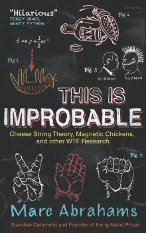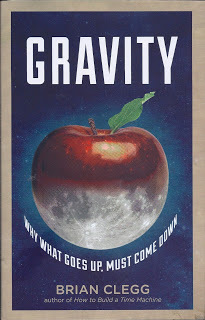Brian Clegg's Blog, page 132
October 18, 2012
But is it art?
 brown vista with blue thingsIt's not art. It's not anti-art. Roughly the words of the 'yellowist' who scrawled on the Mark Rothko painting at the Tate Modern. If you read the 'yellowist' manifesto on the subject, it is either a delightful wind-up, or overinflated tosh. I am strongly reminded of the Henry Cecil book
Ways and Means
. In this enjoyable, if slightly dated, book a pair of conmen and their wives perform some excellent examples of what would now be known as the long con. Complicated setups where they fool people into paying them large sums of money.
brown vista with blue thingsIt's not art. It's not anti-art. Roughly the words of the 'yellowist' who scrawled on the Mark Rothko painting at the Tate Modern. If you read the 'yellowist' manifesto on the subject, it is either a delightful wind-up, or overinflated tosh. I am strongly reminded of the Henry Cecil book
Ways and Means
. In this enjoyable, if slightly dated, book a pair of conmen and their wives perform some excellent examples of what would now be known as the long con. Complicated setups where they fool people into paying them large sums of money.In one of the stories, Basil and Nicholas invent a fake school art called something like partists (I don't have my copy to hand to check the actual name) who only paint parts of the body. The plan itself is mostly a way to get round the rather limited gambling rules of the time to run a kind of football pools on paintings, but somehow yellowist always brings back the idea of this made up style - so I hope it is indeed a wind-up.
However, either way I am surprised how little the news coverage has picked up on what, to me, is the obvious point that there really is no difference between the scrawl and the original. There is no talent in Rothko's work and similar 'art'. It really is the case of the emperor's new clothes, or in the case of art, the art world's new works. There is nothing there to appreciate.
Above you will see my original art work 'brown vista with blue things' (it is essential that the title is only rendered in lower case). I am proud of this. It took me at least 2 minutes to create on my iPad. I genuinely feel that the longer you look at it, the more you will see in it. This is actually a function of the way the brain works. What I can't see is any difference between this and the Rothko in terms of artistic merit, except mine has more interesting patterns in it. What makes his red blobs great (expensive) art and mine worthless? The interpretation? In that case it's not the picture that's art, it's the words that describe it. And let's face it they are pseudo-intellectual claptrap. The man who did it? Then we're looking at the merits of designer labels, not art.
I find it hilarious when they show the gallery and inevitably someone is sitting one of those rather uncomfortable gallery benches, staring at a canvas with a few strokes of paint on it that some conman or other has persuaded a naive and brainless 'elite' to spend millions of pounds on. They should go out and sit on a bench and contemplate nature or the stars instead. Because there really is something to see there.
P.S. A serious question. Could you honestly say if you went in Tate Modern and saw the picture above on the wall labelled as a serious work by a serious painter, that you would immediately spot that it wasn't? If you say yes, I think you need to re-examine your honest circuits, they're on the blink.
Published on October 18, 2012 00:30
October 17, 2012
Voting for police commissioners is idiotic
 Like me, if you live in the UK and you are on the electoral register, you will probably have had one of these through the letterbox: an invitation to go and vote for your friendly local police commissioner. (Sorry, I just can't say that without thinking of Batman and Commissioner Gordon.)
Like me, if you live in the UK and you are on the electoral register, you will probably have had one of these through the letterbox: an invitation to go and vote for your friendly local police commissioner. (Sorry, I just can't say that without thinking of Batman and Commissioner Gordon.)I think this is probably the most stupid thing the present government has done: electing someone to the job of police commissioner. I mean, think about it. Imagine you ran a big business and you are recruiting someone to an important position. What would you say to the HR person who came along and said 'I have a bright idea! Instead of the usual recruitment process, we'll ask each candidate to produce a glossy brochure about themselves (though you won't see all of them), and you will then give the job to the person whose brochure you like best! {Bright HR person smile}' If that happened you would be advertising for two jobs: the original one and a new HR person.
So how would I appoint a police commissioner? I would use the existing jury service system to call together an electoral jury for the police area. That jury would do exactly what an appointment board would do for a real job. Read an application form, see the results of psychometric and problem solving testing (yes, our would-be commissioners would have to undergo testing, shock, horror) and interview each candidate before deciding on the best person for the job.
Which approach do you think would get the best candidate?
Come to think of it, what about MPs? I don't propose removing the franchise to elect MPs, that's too important for democracy. But at the moment we know very little about our MPs before we vote for them. So I would have several electoral juries assessing each candidate and the results of those assessments would be put online (including videos of the interviews) for everyone to see. You could look at each would-be-MP's psychometric and problem solving test results, read their application forms, watch their interviews.
Why several juries? Because I think would-be-MPs ought to be tested on a number of areas, so I would have juries with a range of specialities. These might be:
Local issuesFinanceForeign affairsEducationScienceHealthEnvironment
The 'local issues' jury would be for any voter from the electoral district, but we could give weighting to people with expertise in science etc. for the specialist area juries. Each jury would recommend a person for the job, information that would also be available to voters along with the test results, videos etc.
What's not to like?
Published on October 17, 2012 01:04
October 16, 2012
Nano nightmares
Nanotechnology, like genetically modified food or nuclear power, often produces a knee-jerk reaction. It’s somehow ‘not natural’ and so is considered scary and dangerous. This is primarily a reaction to words, the same way that it easy for advertisers to push emotional buttons with ‘natural’ as good and ‘artificial’ as bad.
This is a silly distinction. There is a lot in nature that is very dangerous indeed – and much that is artificial protects us from that. If you doubt this, try removing everything artificial when you are flying in a plane over shark infested waters. For that matter, many of the most virulent poisons like ricin and botulinus toxin are natural. Water crammed with bacteria and faecal matter is natural. Clean, safe drinking water from a tap is artificial. Yet we can’t help reacting like puppets when the advertisers use those magic words.
 Sub-microscopic machines: NOT what we're talking aboutSome concerns about nanotechnology are down to what is at best futurology and at worst science fiction. Prince Charles infamously caused headlines back in 2003, when newspapers reported ‘The prince has raised the spectre of the “grey goo” catastrophe in which sub-microscopic machines designed to share intelligence and replicate themselves take over and devour the planet.’
Sub-microscopic machines: NOT what we're talking aboutSome concerns about nanotechnology are down to what is at best futurology and at worst science fiction. Prince Charles infamously caused headlines back in 2003, when newspapers reported ‘The prince has raised the spectre of the “grey goo” catastrophe in which sub-microscopic machines designed to share intelligence and replicate themselves take over and devour the planet.’Charles later denied ever meaning this, commenting that he never used the expression ‘grey goo’ and saying ‘I do not believe that self-replicating robots, smaller than viruses, will one day multiply uncontrollably and devour our planet. Such beliefs should be left where they belong, in the realms of science fiction.’ But he certainly did express concerns that not enough was being done to assess and manage any risk associated with the use of nanotechnology.
Unlike the grey goo headlines, this is a perfectly reasonable attitude. The very nature of nanotechnology implies using substances in physical formats that our bodies might not have encountered, and hence we can’t make assumptions without appropriate testing and risk assessment.
If we are to be sensible about this, we need to first avoid a blanket response to nanotechnology. You would be hard pressed to find a reason for being worried about the impact of nanometer thin coatings, such as that used by P2i (sponsors of the Nature’s Nanotech series) There is a big difference between manipulating coatings at the nanoscale and manufacturing products with nanoparticles and small nanotubes.
We know that breathing in nanoparticles, like those found in soot in the air, can increase risk of lung disease, and there is no reason to think that manufactured nanoparticles would be any less dangerous than the natural versions. When some while ago the Soil Association banned artificial nanoparticles from products they endorsed, I asked them why only artificial particles. Their spokesperson said that natural ones are fine because ‘life evolved with these.’
This, unfortunately, is rubbish. You might as well argue it is okay to put natural salmonella into food because ‘life evolved with it.’ Life also evolved with cliffs, but it doesn’t make falling off them any less dangerous. There is no magic distinction between a natural and an artificial substance when it comes to chemical makeup, and in practice if there is risk from nanoparticles it is likely to be from the physics of their very small size, rather than anything about their chemistry.
There are three primary concerns about nanoparticles – what will happen if we breathe them, eat them and put them on our skin. The breathing aspect is probably the best understand and is already strongly legislated on in the UK – we know that particulates in the air can cause a range of diseases and have to be avoided. There is really no difference here between the need to control nanoparticles and any other particles and fibres we might breathe. Whenever a process throws particulates into the air it ought to be controlled. (And this applies to the ‘natural’ smoke from wood fires, say, which is high in dangerous particulates, as well as any industrial process.)
When it comes to food, we have good coverage from The House of Lords Science and Technology committee in a 2010 report. They point out that nanotechnologies have a range of possible applications in food that could benefit both consumers and industry. ‘These include creating foods with unaltered taste but lower fat, salt or sugar levels, or improved packaging that keeps food fresher for longer or tells consumers if the food inside is spoiled.’
The committee’s report sensibly argued ‘Our current understanding of how [nanoparticles] behave in the human body is not yet advanced enough to predict with any certainty what kind of impact specific nanomaterials may have on human health. Persistent nanomaterials are of particular concern, since they do not break down in the stomach and may have the potential to leave the gut, travel throughout the body, and accumulate in cells with long-term effects that cannot yet be determined.’
 Their recommendation was not to abandon these technologies, but rather that it was essential to perform appropriate research, preferably across the EU, to check the impact of such nanomaterials when consumed, and to ensure that all such materials that interact differently with the body from ordinary foodstuffs are assessed for risk before they are allowed onto the market. This seems eminently sensible.
Their recommendation was not to abandon these technologies, but rather that it was essential to perform appropriate research, preferably across the EU, to check the impact of such nanomaterials when consumed, and to ensure that all such materials that interact differently with the body from ordinary foodstuffs are assessed for risk before they are allowed onto the market. This seems eminently sensible.The final area, applying nanoparticles to the skin, is perhaps most urgent, because most of apply them on a regular basis. Most sun defence products, and a number of cosmetics contain them. It is hard to find a good reason to allow for any risk in a pure cosmetic, and arguably they should be prevented from containing nanoparticles. But the story is more nuanced with sun creams.
Most sunscreens contain particles of titanium dioxide or zinc oxide. These invisible particles, ranging from nanoscale to significantly larger, provide most of the sunscreen’s protection against dangerous ultraviolet. What has to be weighed up is the benefits of using products to prevent a cancer that kills over 65,000 people a year worldwide – and would kill many more if sunscreens weren’t used – against a risk that has not been associated with any known deaths.
 The potential for these nanoparticles to cause harm depends on them penetrating through the outer layers of the skin to reach cells where they could cause damage. In theory a nanoparticle is capable of doing this. But the current evidence is that the particles remain on the surface of the skin and do not reach viable skin cells. Skin cancer is a particular risk in Australia, so this is a topic that has been studied in depth there. As Cancer Council Australia concludes: ‘there is no credible evidence that sunscreens containing nanoparticles pose a health risk. There is plenty of evidence however, proving that sunscreen can help reduce the risk of skin cancer, in particular non-melanoma skin cancer.’
The potential for these nanoparticles to cause harm depends on them penetrating through the outer layers of the skin to reach cells where they could cause damage. In theory a nanoparticle is capable of doing this. But the current evidence is that the particles remain on the surface of the skin and do not reach viable skin cells. Skin cancer is a particular risk in Australia, so this is a topic that has been studied in depth there. As Cancer Council Australia concludes: ‘there is no credible evidence that sunscreens containing nanoparticles pose a health risk. There is plenty of evidence however, proving that sunscreen can help reduce the risk of skin cancer, in particular non-melanoma skin cancer.’Overall, then, we should not be lax about nanoparticles and their effect on our bodies. We need careful testing and where necessary regulation. But equally we should not be swayed into knee-jerk reactions by emotional words carrying little meaning.
Images from iStockPhoto
Published on October 16, 2012 00:40
October 15, 2012
Prometheus versus Cabin in the Woods
Over the weekend we had a bit of an iTunes smackdown, watching Ridley Scott's prequel to Alien, Prometheus and the Joss Whedon produced Cabin the Woods. I can't say either was brilliant, but I definitely preferred the lower budget number.
 First, Prometheus. You have to say there was great CGI - very realistic looking. Inevitably there were movie references - I couldn't help sniggering when a ship's computer with a voice like HAL addressed someone called David. That couldn't be a coincidence, even though there were no pod bay doors mentioned. And there is no doubt that Ridley Scott has a good line in creating tension. Of course if you've seen Alien (I did first time round in the cinema) once the protagonists got in the room with lots of egg-like cylinders you couldn't help feel a little nervous for them. But even though Alien was little more than hide and seek in space, it was very good, tense hide and seek in space, where I struggled more to get engaged in Prometheus.
First, Prometheus. You have to say there was great CGI - very realistic looking. Inevitably there were movie references - I couldn't help sniggering when a ship's computer with a voice like HAL addressed someone called David. That couldn't be a coincidence, even though there were no pod bay doors mentioned. And there is no doubt that Ridley Scott has a good line in creating tension. Of course if you've seen Alien (I did first time round in the cinema) once the protagonists got in the room with lots of egg-like cylinders you couldn't help feel a little nervous for them. But even though Alien was little more than hide and seek in space, it was very good, tense hide and seek in space, where I struggled more to get engaged in Prometheus.
There was very little plot structure, the aliens were tediously consistent in being homicidal monsters and I really didn't care for many of the characters. Whenever Hollywood does someone really old by piling on the rubber it looks so fake that you wonder why they can get monsters right but not this - the really old man, who was an important part of what plot there was, was truly bad. (On the plus side, Charlize Theron was stunning, if something of a cipher.)
I'm afraid I couldn't help but laugh aloud at one point, when two of the protoganists were trying to run away from a huge space ship that was falling on them... by running along the length of the ship rather than going sideways and covering a fraction of the distance to safety. It was pure Road Runner. And the baby Alien at the end looked far too much like a child dressed like Alien for Halloween. All in all it made me appreciate how brilliant Blade Runner still is. But at least Prometheus was better than the remake of Total Recall.
 So we come to Cabin in the Woods. This was a relatively low budget movie that for some reason was shelved for several years before it came out. Despite getting very mixed reviews, I had to love it to some degree as I'm a huge Joss Whedon fan. Buffy, Angel, Firefly and Dollhouse all score high amongst my favourite TV. And Whedon didn't do badly with the Avengers Assemble movie, though I think his ability to combine drama, fantasy horror/science fiction and big dollops of humour works best on TV because there's more time for things to develop. He also has more chance to produce his trademark reversal of expectation in TV - but having said that, this was something this film certainly packed in. Whedon wasn't the director, but he was writer and producer, and it shows.
So we come to Cabin in the Woods. This was a relatively low budget movie that for some reason was shelved for several years before it came out. Despite getting very mixed reviews, I had to love it to some degree as I'm a huge Joss Whedon fan. Buffy, Angel, Firefly and Dollhouse all score high amongst my favourite TV. And Whedon didn't do badly with the Avengers Assemble movie, though I think his ability to combine drama, fantasy horror/science fiction and big dollops of humour works best on TV because there's more time for things to develop. He also has more chance to produce his trademark reversal of expectation in TV - but having said that, this was something this film certainly packed in. Whedon wasn't the director, but he was writer and producer, and it shows.
Whedon fans will be delighted that three of his rep company are present in the cast, though mostly underused, apart from the nerdy self-deceiving scientist from Dollhouse, who is excellent as a stoned fool who turns out to be a key character against all expectation. It might be portrayed as a traditional teen horror slasher, but the first scenes with a kind of industrial control room, manipulating what's going on in the teens' horror story make it clear that it's something different and won't play as expected. (One of the best bits was the phone conversation with the evil harbinger at the gas station near the cabin, who really gets peeved when he finds the control room has him on speakerphone to laugh at his portentous remarks.)
In the end, I don't think it quite works. The overall concept is brilliant if bonkers, and some parts of it work well, but the ending clearly was a 'we can't think want to do next' bit of writing. Having said that, a major theme in Buffy et al is how you might have to sacrifice your friends and everything to save the world. The ending inverts this traditional Whedon mainstay by putting friendship ahead of saving the world.
I can't stand gore/slasher movies like Texas Chainsaw Massacre or Saw, so when it turned out that some of the baddies would be zombies with TCM tendencies I was not thrilled - but actually even though there are times when a scene is absolutely swilling with human blood, you don't see too much detail, which makes it more acceptable for me. For all its problems, there was much more originality and inventiveness in Cabin in the Woods than there was in Prometheus and I have to say it made for much the more enjoyable evening of the two.
Both are now available on DVD/Blu-ray.
 First, Prometheus. You have to say there was great CGI - very realistic looking. Inevitably there were movie references - I couldn't help sniggering when a ship's computer with a voice like HAL addressed someone called David. That couldn't be a coincidence, even though there were no pod bay doors mentioned. And there is no doubt that Ridley Scott has a good line in creating tension. Of course if you've seen Alien (I did first time round in the cinema) once the protagonists got in the room with lots of egg-like cylinders you couldn't help feel a little nervous for them. But even though Alien was little more than hide and seek in space, it was very good, tense hide and seek in space, where I struggled more to get engaged in Prometheus.
First, Prometheus. You have to say there was great CGI - very realistic looking. Inevitably there were movie references - I couldn't help sniggering when a ship's computer with a voice like HAL addressed someone called David. That couldn't be a coincidence, even though there were no pod bay doors mentioned. And there is no doubt that Ridley Scott has a good line in creating tension. Of course if you've seen Alien (I did first time round in the cinema) once the protagonists got in the room with lots of egg-like cylinders you couldn't help feel a little nervous for them. But even though Alien was little more than hide and seek in space, it was very good, tense hide and seek in space, where I struggled more to get engaged in Prometheus.There was very little plot structure, the aliens were tediously consistent in being homicidal monsters and I really didn't care for many of the characters. Whenever Hollywood does someone really old by piling on the rubber it looks so fake that you wonder why they can get monsters right but not this - the really old man, who was an important part of what plot there was, was truly bad. (On the plus side, Charlize Theron was stunning, if something of a cipher.)
I'm afraid I couldn't help but laugh aloud at one point, when two of the protoganists were trying to run away from a huge space ship that was falling on them... by running along the length of the ship rather than going sideways and covering a fraction of the distance to safety. It was pure Road Runner. And the baby Alien at the end looked far too much like a child dressed like Alien for Halloween. All in all it made me appreciate how brilliant Blade Runner still is. But at least Prometheus was better than the remake of Total Recall.
 So we come to Cabin in the Woods. This was a relatively low budget movie that for some reason was shelved for several years before it came out. Despite getting very mixed reviews, I had to love it to some degree as I'm a huge Joss Whedon fan. Buffy, Angel, Firefly and Dollhouse all score high amongst my favourite TV. And Whedon didn't do badly with the Avengers Assemble movie, though I think his ability to combine drama, fantasy horror/science fiction and big dollops of humour works best on TV because there's more time for things to develop. He also has more chance to produce his trademark reversal of expectation in TV - but having said that, this was something this film certainly packed in. Whedon wasn't the director, but he was writer and producer, and it shows.
So we come to Cabin in the Woods. This was a relatively low budget movie that for some reason was shelved for several years before it came out. Despite getting very mixed reviews, I had to love it to some degree as I'm a huge Joss Whedon fan. Buffy, Angel, Firefly and Dollhouse all score high amongst my favourite TV. And Whedon didn't do badly with the Avengers Assemble movie, though I think his ability to combine drama, fantasy horror/science fiction and big dollops of humour works best on TV because there's more time for things to develop. He also has more chance to produce his trademark reversal of expectation in TV - but having said that, this was something this film certainly packed in. Whedon wasn't the director, but he was writer and producer, and it shows.Whedon fans will be delighted that three of his rep company are present in the cast, though mostly underused, apart from the nerdy self-deceiving scientist from Dollhouse, who is excellent as a stoned fool who turns out to be a key character against all expectation. It might be portrayed as a traditional teen horror slasher, but the first scenes with a kind of industrial control room, manipulating what's going on in the teens' horror story make it clear that it's something different and won't play as expected. (One of the best bits was the phone conversation with the evil harbinger at the gas station near the cabin, who really gets peeved when he finds the control room has him on speakerphone to laugh at his portentous remarks.)
In the end, I don't think it quite works. The overall concept is brilliant if bonkers, and some parts of it work well, but the ending clearly was a 'we can't think want to do next' bit of writing. Having said that, a major theme in Buffy et al is how you might have to sacrifice your friends and everything to save the world. The ending inverts this traditional Whedon mainstay by putting friendship ahead of saving the world.
I can't stand gore/slasher movies like Texas Chainsaw Massacre or Saw, so when it turned out that some of the baddies would be zombies with TCM tendencies I was not thrilled - but actually even though there are times when a scene is absolutely swilling with human blood, you don't see too much detail, which makes it more acceptable for me. For all its problems, there was much more originality and inventiveness in Cabin in the Woods than there was in Prometheus and I have to say it made for much the more enjoyable evening of the two.
Both are now available on DVD/Blu-ray.
Published on October 15, 2012 00:41
October 12, 2012
The Perishers Dilemma
 Where a Perishers strip would be shown if I had confidence I owned itAs I think I have mentioned before, I am a great fan of the old UK comic strip
The Perishers
. This started, I suspect, as an attempt to cash in on the success of Peanuts in the US, but it very quickly developed a feel and approach that was all its own. Although the humour could sometimes be childish, it often had a surreal character that lifted it far above its apparent level. I don't know if Wellington's habit of remarking something like 'Colour me amazed' originated with the cartoon, but it was certainly highly appropriate for a black and white strip.
Where a Perishers strip would be shown if I had confidence I owned itAs I think I have mentioned before, I am a great fan of the old UK comic strip
The Perishers
. This started, I suspect, as an attempt to cash in on the success of Peanuts in the US, but it very quickly developed a feel and approach that was all its own. Although the humour could sometimes be childish, it often had a surreal character that lifted it far above its apparent level. I don't know if Wellington's habit of remarking something like 'Colour me amazed' originated with the cartoon, but it was certainly highly appropriate for a black and white strip.However, this post isn't really about the Perishers per se but about the whole position of reproduction rights of a work of art. Specifically, if I buy an original artwork, do I own it or not?
The reason I ask this is that is that many years ago, a friend who knew I loved The Perishers very kindly bought the original artwork of one of the strips for me. I assume I own this - it was certainly paid for. Yet do I have the right to reproduce that strip on this page? I really don't know. Anything else I own I would say 'yes.' And surely it's only fair if the thing is the original and has been paid for that I can do so. Yet I have a suspicion that I don't have that right. Which seems a little unfair.
Published on October 12, 2012 00:50
October 11, 2012
The Rise and Rise of Linked-in
 I was a member of Linked-in, sometimes described as Facebook for business, before I'd even heard the term social networking, but for years did nothing with it. In fact, if someone asked me to be added as a contact, I used to reply 'Yes, but I rarely use it.' Now something has changed.
I was a member of Linked-in, sometimes described as Facebook for business, before I'd even heard the term social networking, but for years did nothing with it. In fact, if someone asked me to be added as a contact, I used to reply 'Yes, but I rarely use it.' Now something has changed.I have started taking Linked-In seriously. What tipped me over the edge was an email conversation with a publicist at a publisher. I had asked said publicist if she knew what had happened to an editor at a magazine I had written for in the past, as the email address was bouncing. Oh, yes, said the publicist, according to Linked-in she (the editor) has moved to work here (a different company). And within seconds I was back in contact with said editor.
The light bulb went on. I finally saw the point.
So since then I have been working on expanding my Linked-in connections and making myself more visible in the environment. It genuinely is a valuable tool for keeping in touch on the business side - much more reliably so than Facebook or Twitter. I won't drop either of those as they have a different, if overlapping, world of people - but I am now treating Linked-in with respect.
Apart from anything else, I absolutely love going on Linked-in and scrolling through the 'People you may know' page. This is a list of contacts of contacts and it's fascinating, because it takes me back to previous workplaces with all sorts of names that bring back memories, and it takes me off into new interesting new areas, particularly with new science communication contacts. Brilliant. It's contact porn.
If I pull it up now I have in front of me the Head of Planning at British Airways, freelance writers, editor of Science Radio at the BBC, a Fellow of Churchill College, Cambridge, an administrator at Swansea Met University, a New Scientist editor, the Chief Executive at World Book Night, the Web Development Manager for Tesco... it is truly awesome.
Are you on Linked-in yet?
Published on October 11, 2012 01:10
October 10, 2012
Public key, private key banking
 Money, made easyI was standing in the queue to pay at M&S food yesterday and noticed a leaflet for their new current account. 'The only trouble with switching current accounts is,' I thought, 'it's a pain.' And despite all supposed efforts to make it easier, particularly for business, this remains the case. All the more so now most of our payments are done electronically, so a change of account means getting the finance department of every client/customer to change their systems. And we know how good finance departments are at making changes.
Money, made easyI was standing in the queue to pay at M&S food yesterday and noticed a leaflet for their new current account. 'The only trouble with switching current accounts is,' I thought, 'it's a pain.' And despite all supposed efforts to make it easier, particularly for business, this remains the case. All the more so now most of our payments are done electronically, so a change of account means getting the finance department of every client/customer to change their systems. And we know how good finance departments are at making changes.Yet we can switch mobile phone company, transfer our number and zingo! Calls still keep coming in. As long as you have your own URL, the same goes for email address - I've changed ISP twice, but my email address hasn't altered since 1994. So why can't bank accounts be like this?
What we need is to model bank account access on the public key, private key encryption mechanism. In this clever security system, you have a public key that you merrily give to anyone and everyone freely that enables encryption - but you need a separate key that only you know to do the decryption.
My bank equivalent would be that you have a public account number that stays with you for life and that you can let everyone and anyone know. You can stick it in large letters on your website. And that is all that is needed to pay into your bank account. It is bank independent - it's just for you. So when you move banks, anyone paying you still pays to the same public account number and it reaches your new bank. Simples.
Paying out is a different matter. In my scheme you would have a private key to enable money to go out of your account, and that key would only be shared with one individual - the payee. You would have a different key for each relationship between you and a payee (you wouldn't need to see this, it could all be covered by the software, just as the public key/private key is online). If it was a one-off payment you could include the amount in the key - if it's a direct debit or equivalent it would specify the duration. No one else could use it.
With these in place you have two things. The ability to switch bank accounts without informing everyone of a change of details, and much better security. What's not to like? Would the banks do it? I doubt it. But I can dream...
Published on October 10, 2012 00:40
October 9, 2012
Musical metaphors
With the exception of a post about a dubious advertising campaign that I had to take down in response to a cease and desist order, my blog post that has generated the most comments (and certainly the most ire) is one about my dislike for opera. I like to revisit it occasionally, if only to add accelerant to the flames.
On Sunday I was driving back to sunny Swindon from darkest Southampton and happened to have Classic FM's chart show on, which featured a couple of operatic numbers and it struck me that there was a very useful metaphor to be had for the nature of operating singing when compared with my own favourite singing form, Tudor/Elizabethan/20th Century church music, in the manner of ice cream desserts.
Operatic singing, I would say, is like a visit to Pizza Hut's Ice Cream Factory (R). As well the gooey, sweet icecream, you can pile on the hundreds and thousands and marshmallows and Smarties and sauce to make something that is over-the-top, dramatic and altogether remarkable, if a little predictable. Listening to a piece by Byrd or Palestrina by comparison is like taking on a Heston Blumenthal ice cream. It's a sophisticated taste, and frankly a lot of people probably won't get it. Not only is it subtle but it can shock you by putting things you would never expect together (musically speaking).
The important thing here is that both are, in there own way, appealing. Neither will work for everyone, though more people are likely to get the Ice Cream Factory approach. I'm not saying I'm a convert. But I think I understand the appeal better now. And life would be boring (and not like Forrest Gump's box of chocolates) if we all like the same things.
On Sunday I was driving back to sunny Swindon from darkest Southampton and happened to have Classic FM's chart show on, which featured a couple of operatic numbers and it struck me that there was a very useful metaphor to be had for the nature of operating singing when compared with my own favourite singing form, Tudor/Elizabethan/20th Century church music, in the manner of ice cream desserts.
Operatic singing, I would say, is like a visit to Pizza Hut's Ice Cream Factory (R). As well the gooey, sweet icecream, you can pile on the hundreds and thousands and marshmallows and Smarties and sauce to make something that is over-the-top, dramatic and altogether remarkable, if a little predictable. Listening to a piece by Byrd or Palestrina by comparison is like taking on a Heston Blumenthal ice cream. It's a sophisticated taste, and frankly a lot of people probably won't get it. Not only is it subtle but it can shock you by putting things you would never expect together (musically speaking).
The important thing here is that both are, in there own way, appealing. Neither will work for everyone, though more people are likely to get the Ice Cream Factory approach. I'm not saying I'm a convert. But I think I understand the appeal better now. And life would be boring (and not like Forrest Gump's box of chocolates) if we all like the same things.
Published on October 09, 2012 00:30
October 8, 2012
Stand up science
 Last Friday at Oxford I had my first experience of contributing to a sort of stand up science - and it was great fun.
Last Friday at Oxford I had my first experience of contributing to a sort of stand up science - and it was great fun.The event, in the hallowed halls of Oxford's Mathematical Institute was, in effect, part of a book tour for Ig Nobel Prize founder Marc Abrahams' new book This is Improbable. As this is a series of short articles it is quite difficult to do a talk about, so Abrahams has hit on a brilliant way of covering the topic. His book describes a whole host of the sort of whacky papers that make you laugh and then think - the kind of thing that typify the Ig Nobel prizes. And what Abrahams does is brings along a pile of the original papers, gives them out to guest speakers like me and then each of us is given 2 minutes to read snippets from the paper as a dramatic rendition.
It works surprisingly well - though some readers were better than others at what was a fairly frantic bit of preparation to make snippets from an academic paper seem entertaining. To add to the fun, after each reading the audience had the opportunity to question the reader about the details of a paper that they'd never seen before.
I chose a paper that studied the effects of wearing socks over your shoes on an icy pavement in New Zealand, a paper that luckily had a number of priceless phrases to quote. (I knew I'd do okay when the audience burst into laughter at the revelation that the experimenters had issued their test subjects with different coloured socks.) Others, I think, found the experience a little wearing. Marc Abrahams was standing alongside us and frequently had to prompt readers to stop breaking the rules by commenting on a paper rather than simply quoting it.
There was one heartstopping moment when one of the other readers, another science writer, who was presenting a paper about racial preference in choosing colour of cheese, was asked a question from the audience about whether the study covered people of mixed race. The science writer turned to the timekeeper on the stage and said something like 'You're mixed race, what do you think?' It felt horribly like one of those moments when someone says 'I didn't know you were pregnant,' to get the reply 'I'm not.'
Overall, though, brilliant fun. Click here for a review of the book/links to Amazon.
Published on October 08, 2012 00:54
October 5, 2012
Re-cover-y
 I am delighted to announce that my latest book,
Gravity
is now available in the UK as well as the US. My first encounter with it was a bit of a shock, when I turned up at my talk in Lichfield last Sunday and there it was for sale - but I now have my own copies, so it seem real.
I am delighted to announce that my latest book,
Gravity
is now available in the UK as well as the US. My first encounter with it was a bit of a shock, when I turned up at my talk in Lichfield last Sunday and there it was for sale - but I now have my own copies, so it seem real.There was one other surprise, though. I was expecting a white cover featuring Harold Lloyd hanging off a huge clock face, clearly being seriously influenced by gravity and fitting the new tag line dreamed up by UK publisher Duckworth 'What goes up, must come down.' At the time of writing, the Harold Lloyd cover is still on Amazon. But instead we have the cover shown here - about as different as you can get.
I rather like the new cover. It has gravitas, which is rather appropriate. The earlier cover suffered, perhaps, from too much levity. (Gravity and levity were in ancient Greek times simple opposing tendencies. Heavy objects had an urge, a desire even, to head towards the centre of the universe, i.e. the Earth. This urge was gravity. Light objects had an urge to move away from the centre of the universe - levity.) It's rather handsome too with that subtle blend of the apple and the Moon having nice Newtonian connotations.
But a little part of me misses Harold Lloyd...
Published on October 05, 2012 00:15



